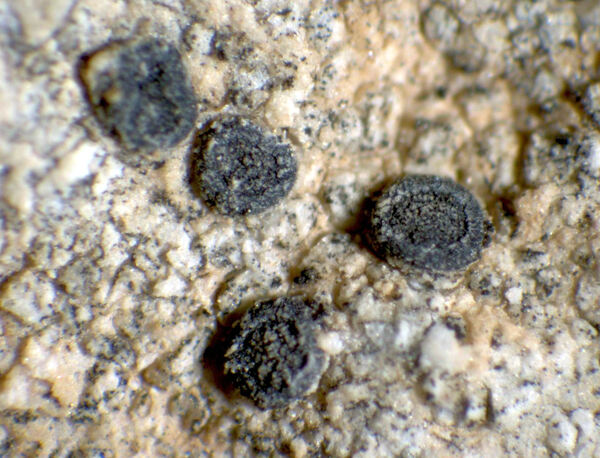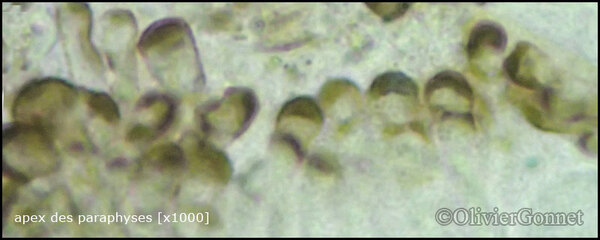Rinodinella dubyanoides (Hepp) H. Mayrhofer & Poelt
Hoppea, 37: 98, 1978. Basionym: Lecidea dubyanoides Hepp - Flecht. Eur.: nr. 323, 1857.
Synonyms: Buellia dubyanoides (Hepp) Müll. Arg.; Buellia dubyanoides var. evoluta Zahlbr.; Lecanora aequatula Nyl.; Lecanora dubyanoides (Hepp) Stizenb.; Rinodina aequatula (Nyl.) B. de Lesd.; Rinodina dubyanoides (Hepp) Arnold; Rinodina dubyanoides var. evoluta Zahlbr.; Rinodina minuta B. de Lesd.; Rinodina subgranulata Müll. Arg.
Distribution: N - VG, TAA, Lomb. C - Tosc, Sar. S - Camp (Aprile & al. 2003, 2003b), Pugl (Nascimbene & al. 2021), Cal (Puntillo 1996), Si (Ottonello & Salone 1994, Grillo & Caniglia 2004, Caniglia & Grillo 2005, 2006).
Description: Thallus endosubstratic or very thinly episubstratic, usually poorly evident, whitish to grey. Apothecia initially lecanorine and immersed in thallus, becoming cryptolecanorine and sessile, with a dark brown to black, 0.2-0.4(-0.6) mm wide, concave to flat disc and a thin, whitish, rapidly excluded thalline margin; proper margin thick, prominent and entire at first, becoming thinner with age, usually persistent. Epithecium reddish brown, K-; hymenium colourless, 60-80 µm high; hypothecium colourless. Asci 8-spored, narrowly clavate to clavate, the K/I+ blue tholus penetrated by a faintly amyloid apical cushion with parallel or diverging flanks, the wall K/I-, surrounded by a K/I+ blue outer layer, Lecanora-type. Ascospores 1-celled, pale brown, thin-walled throughout, 12-18 x 5-7.5 µm, Rinodinella-type, the wall not ornamented, the septum very thin (1 μm or less), with ontogeny of type A. Conidia bacilliform, 5-6 x c. 1 µm. Photobiont chlorococcoid. Spot tests: K-, C-, KC-, P-, UV-. Chemistry: without lichen substances. Note: a mild-temperate to Mediterranean species found on hard, compact calcareous rocks, mostly on steeply inclined faces wetted by rain, below the subalpine belt.
Growth form: Crustose endolithic
Substrata: rocks
Photobiont: green algae other than Trentepohlia
Reproductive strategy: mainly sexual
Commonnes-rarity: (info)
Alpine belt: absent
Subalpine belt: absent
Oromediterranean belt: absent
Montane belt: rare
Submediterranean belt: rather rare
Padanian area: absent
Humid submediterranean belt: rather rare
Humid mediterranean belt: rare
Dry mediterranean belt: very rare
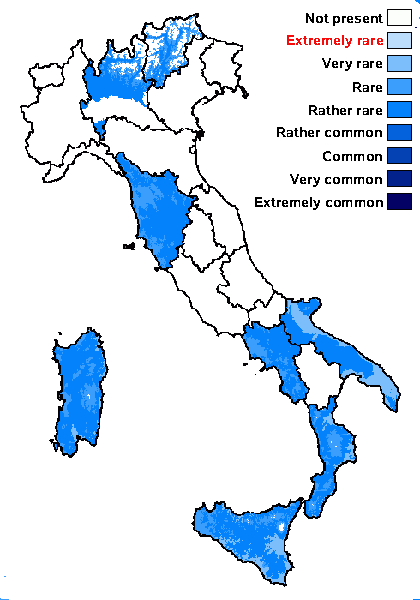
Predictive model
Herbarium samples
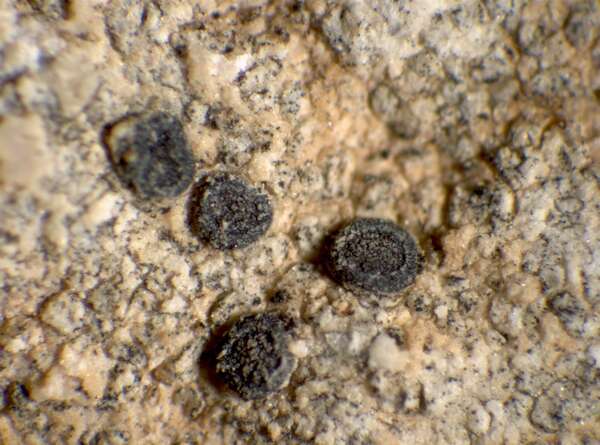

P.L. Nimis; Owner: Department of Life Sciences, University of Trieste
Herbarium: TSB (24289)
2001/12/10
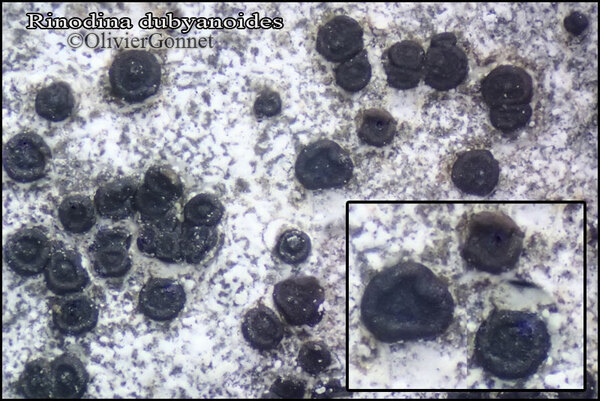
Courtesy Danièle et Olivier Gonnet - Source: https://www.afl-lichenologie.fr/Photos_AFL/Photos_AFL_R/Textes_R/Rinodinella_dubyanoides.htm
France, 2/6/2015 - Combe Lavaux - Côte-d'Or
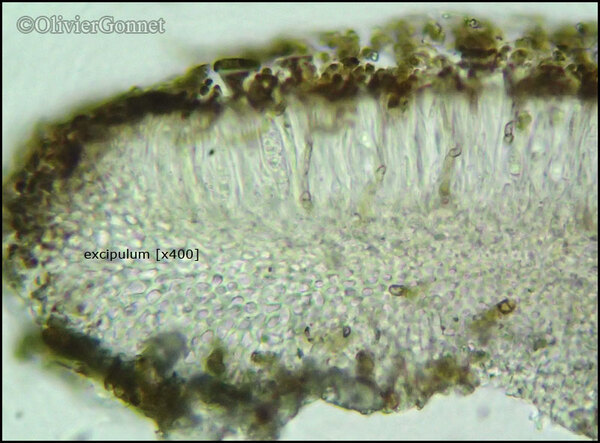
Courtesy Danièle et Olivier Gonnet - Source: https://www.afl-lichenologie.fr/Photos_AFL/Photos_AFL_R/Textes_R/Rinodinella_dubyanoides.htm
France, 2/6/2015 - Combe Lavaux - Côte-d'Or
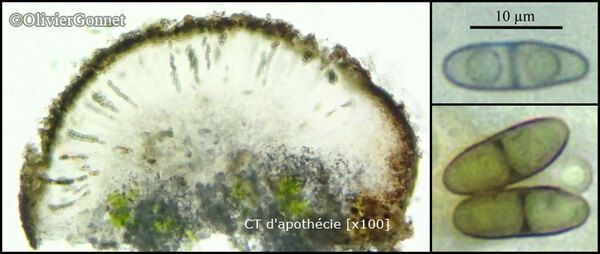
Courtesy Danièle et Olivier Gonnet - Source: https://www.afl-lichenologie.fr/Photos_AFL/Photos_AFL_R/Textes_R/Rinodinella_dubyanoides.htm
France, 2/6/2015 - Combe Lavaux - Côte-d'Or
Growth form: Crustose endolithic
Substrata: rocks
Photobiont: green algae other than Trentepohlia
Reproductive strategy: mainly sexual
Commonnes-rarity: (info)
Alpine belt: absent
Subalpine belt: absent
Oromediterranean belt: absent
Montane belt: rare
Submediterranean belt: rather rare
Padanian area: absent
Humid submediterranean belt: rather rare
Humid mediterranean belt: rare
Dry mediterranean belt: very rare

Predictive model
| Herbarium samples |


P.L. Nimis; Owner: Department of Life Sciences, University of Trieste
Herbarium: TSB (24289)
2001/12/10

Courtesy Danièle et Olivier Gonnet - Source: https://www.afl-lichenologie.fr/Photos_AFL/Photos_AFL_R/Textes_R/Rinodinella_dubyanoides.htm
France, 2/6/2015 - Combe Lavaux - Côte-d'Or

Courtesy Danièle et Olivier Gonnet - Source: https://www.afl-lichenologie.fr/Photos_AFL/Photos_AFL_R/Textes_R/Rinodinella_dubyanoides.htm
France, 2/6/2015 - Combe Lavaux - Côte-d'Or

 INDEX FUNGORUM
INDEX FUNGORUM
 GBIF
GBIF
 DOLICHENS
DOLICHENS
